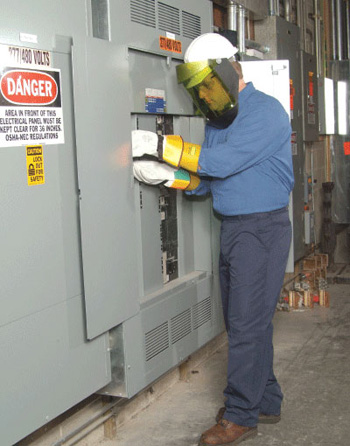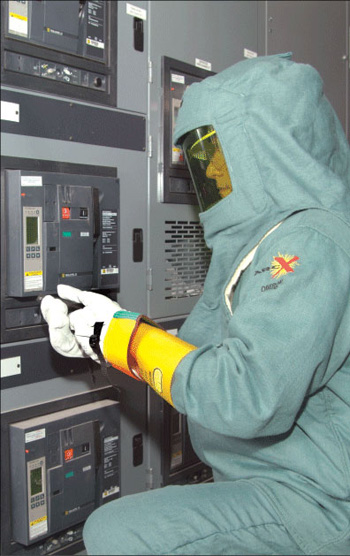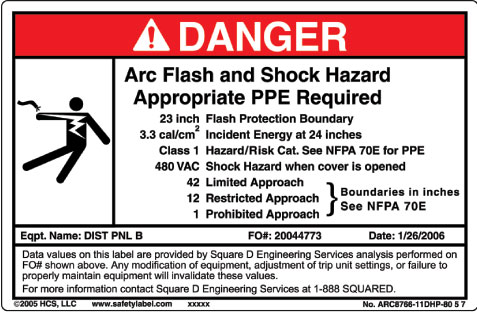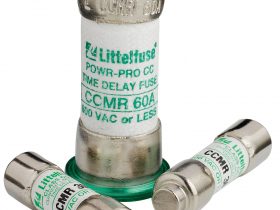Electrical arc-flash and shock hazards have been recognized as particularly dangerous and fairly frequent occurrences that put the lives and health of electrical workers at significant risk. Statistics indicate that five to ten arc-flash accidents that involve a fatality or serious injury to an employee occur every day in the United States.
Those incidents most often occur when personnel are required (or choose) to work on electrical equipment while it is in an electrically energized condition. In an effort to reduce these incidents, the NFPA 70E® standard was published, and OSHA cites it as a definitive resource for employee electrical safety in the workplace.

Photo 1. With a flame resistant (FR) rating of 8 cal/cm2, NFPA 70E-2004 Hazard Risk Category 2* requires full face and neck protection which is provided in this case by a wraparound face shield rated for a minimum of 8 calories per square centimeter.
NFPA 70E 2004 Article 130.1, Justification for Work, is very clear that one of the fundamental requirements for safe electrical work practices in any facility is to place all equipment in an electrically safe work condition (i.e., lockout/tagout) before personnel works on or near the equipment, unless the circumstances meet certain conditions for exemption from that rule that are clearly outlined in NFPA 70E 2004 Article 130.1(A) (3). The arc-flash and shock hazards are only present when electrical equipment is energized, and that includes the steps of performing the process of lockout/tagout up to and including the point that the equipment has been verified to be in an electrically safe work condition, meaning it has been verified as not energized.
Arc-flash accidents result in devastating consequences to the workers involved and their families and are also very costly to the employer and its insurers. The average cost of a survived accident can easily reach $8 million to $10 million in direct and indirect costs. Legal settlements almost always involve citations of deficiencies in the employer’s safety program as a causative factor leading to the accident.
Inspecting energized equipment safely
Electrical inspectors face the same hazards as they perform the inspection process if the equipment is energized. In many cases when the inspector arrives on the jobsite, the equipment is closed up and energized. Many jurisdictions have regulations that require acceptance by the inspector before the equipment is energized, but many others do not. Often, the electrical contractor will energize equipment to troubleshoot or verify proper operation before the inspector arrives on the jobsite. Thus, it is likely in many cases that the equipment will be energized when the inspector arrives, and this presents safety hazards to the inspector whenever it is necessary to open the equipment in the course of the inspection.
Since a fundamental requirement of the NFPA 70E safety standards is to place all equipment in an electrically safe work condition as noted above, this is always the preferred condition prior to inspection. However, in a facility that is energized, the inspector should be aware that this option will often not be a popular approach, because it may disrupt facility operations and final troubleshooting and startup work by the contractor. If inspection must be done with the electrical equipment energized, there are clearly defined safety procedures that must be followed to ensure the safety of the electrical inspector and/or the electrical contractor’s personnel.
First, the NFPA 70E standards are clear that any time electrically energized parts are exposed, such as is the case when equipment covers are open or devices are withdrawn from their cells, only qualified persons are permitted to be in the work area (i.e., the flash protection boundary), and those qualified persons must be protected with the appropriate personal protective equipment (PPE). Unlike older existing facilities, most new facilities will have electrical single-line diagrams that are accurate and up-to-date, and this is critical for safe work, because they will accurately reflect all potential sources of supply to each piece of equipment in the facility. In addition, the short circuit and coordination studies are usually available and accurate in new facilities, and the equipment itself is typically in optimal working condition (i.e., new).
However, unless it was specified in the construction specification documents, it is unusual in a new installation to find that an arc-flash hazard analysis has been completed. This makes it more difficult for the electrical inspector or electrical contractor to know what the specific hazard levels are at each piece of equipment in the system, and the potential hazard levels define the hazard risk category of PPE that is required for energized work. Fortunately, NFPA 70E provides Table 130.7(C)(9)(a), which lists different equipment types, voltage classes and specific work tasks with requirements for appropriate PPE and tools to be used. When consulting this table, care must be taken to follow the footnotes that define the conditions under which the tables may be used.
Any time electrical inspectors need to be within the energized electrical equipment’s flash protection boundary with exposed energized parts to perform the inspection, they must be qualified persons as defined in NFPA 70E Article 100, and they must wear PPE that is appropriate for the hazards that are present. OSHA recognizes that in many cases workers are qualified to work only on electrical equipment at certain voltage levels. For example, many workers are considered by their employer to be qualified to work on energized electrical equipment at low voltage levels (less than 1,000 volts), but not on medium voltage equipment (1,000 volts or greater). Other more highly qualified employees are considered qualified to work at any voltage level.
Being aware

Photo 2. The minimum PPE requirements of NFPA 70E-2004 Hazard Risk Category 4 include protection like an Oberon Arc40 coat, pants and hood with hard cap, along with his Hazard Risk Category 2 PPE. The worker is preparing to rack a Square D® Masterpact
Removal of covers on energized electrical equipment is in itself a fairly hazardous task. Many arc-flash accidents that are reported each year were caused by workers carelessly removing a cover from energized electrical equipment. Some electrical equipment may possess cover interlocks that are concealed and unknown to the inspector. Removing a cover with a concealed cover safety interlock may cause an upstream protective device to open. A good practice for inspectors to follow is to request that the electrical contractor’s qualified personnel remove all covers from equipment to provide access for inspection, and then reinstall the covers after the inspection is complete. The installing contractor should provide this access to the inspector, because the contractor will know the system and the safety requirements, and should be able to perform the task safely. Once the covers are safely removed for inspection, the inspector will still be required by the standards to be a qualified person wearing the appropriate PPE, even for a visual inspection.
It is a common industry practice for equipment manufacturers to ship new electrical equipment with all of the overcurrent protective devices’ trip unit adjustments set to their minimum settings. For example, circuit breakers with adjustable trip unit functions will always be set to minimum settings. During startup, the contractor will set each circuit breaker trip unit to the settings that are recommended in the system protective device time coordination study. Until the overcurrent protective devices have been properly adjusted, placing a load on the system will often result in nuisance tripping of some devices. This tripping is not in itself a safety hazard, but is something of which the electrical inspector should be aware. If a device nuisance trips when the inspector is inspecting the system with equipment doors open, it could startle the inspector or the contractor’s employee, and that could cause an accident to occur.
In Section 110.16, theNational Electrical Coderequires that electrical equipment must be labeled to indicate that there is a potential hazard to the worker of arc flash, arc blast, shock and electrocution. NEC-2005 does not require that specific hazard levels, such as the flash protection boundary distance, arc flash incident energy, PPE hazard risk category, shock protection boundaries and other details, be posted on labels. These “generic” labels are usually placed on new equipment by most manufacturers. Although these labels are useful as a hazard warning, they do not provide much information about the specific hazard levels in that particular installation. It is for that reason that the tables in NFPA 70E are useful until an arc-flash hazard analysis is completed. Future revisions of the NEC, including the 2008 edition, are likely to expand and clarify the labeling requirements, but they probably will not require specific details about the hazard level. Hazard warning labels that show these details are available from some suppliers, but they generally will not be found on equipment in a new installation.

Photo 3. The current requirement for application of hazard warning labels on electrical equipment (National Electrical Code 2005) only requires a generic hazard warning message to the worker. However, many Square D customers have decided to exceed the req
When inspectors work in existing facilities — for example, to inspect new equipment that is added to an existing system — there are a few differences of which they should be aware. Most existing facilities that are more than just a few years old will often not have very accurate documentation, such as the electrical single-line diagram, short circuit study and coordination studies. The reason is that as modifications were made to a facility’s electrical system over time, the existing documentation was not updated to reflect the system changes. Improper documentation, especially an out-of-date single-line diagram, makes the process of lockout/tagout more hazardous for the worker. In lockout/tagout, it is imperative that the worker be able to identify all supply sources to the equipment and all modes of operation in order to make certain that all potential sources are locked out and in an electrically safe work condition to prevent injury. Inaccurate electrical single-line diagrams make this process much more difficult.
In addition, the electrical equipment in older facilities has often not been properly maintained. This lack of maintenance can cause overcurrent protective devices to operate more slowly, or not at all, during an arcing fault, which will cause the arc flash incident energy to be difficult to calculate accurately, and protect against.
Being proactive
As an electrical inspector, your employer probably has a legal obligation to make certain that you are a qualified person according to the definition in NFPA 70E Article 100, that you have proper PPE (and use it), that you are furnished with any tools that are required to perform electrical inspections safely and that you have been properly trained on the hazards involved in performing your work. Your other “employer” — your family — has a vested interest in your continued well-being and safety as well.
But in the end, it is your responsibility to understand the hazards you face and understand how to perform your work safely. Thus, it is paramount to know how to perform your work safely, and be educated on how to protect yourself from injury.














Find Us on Socials